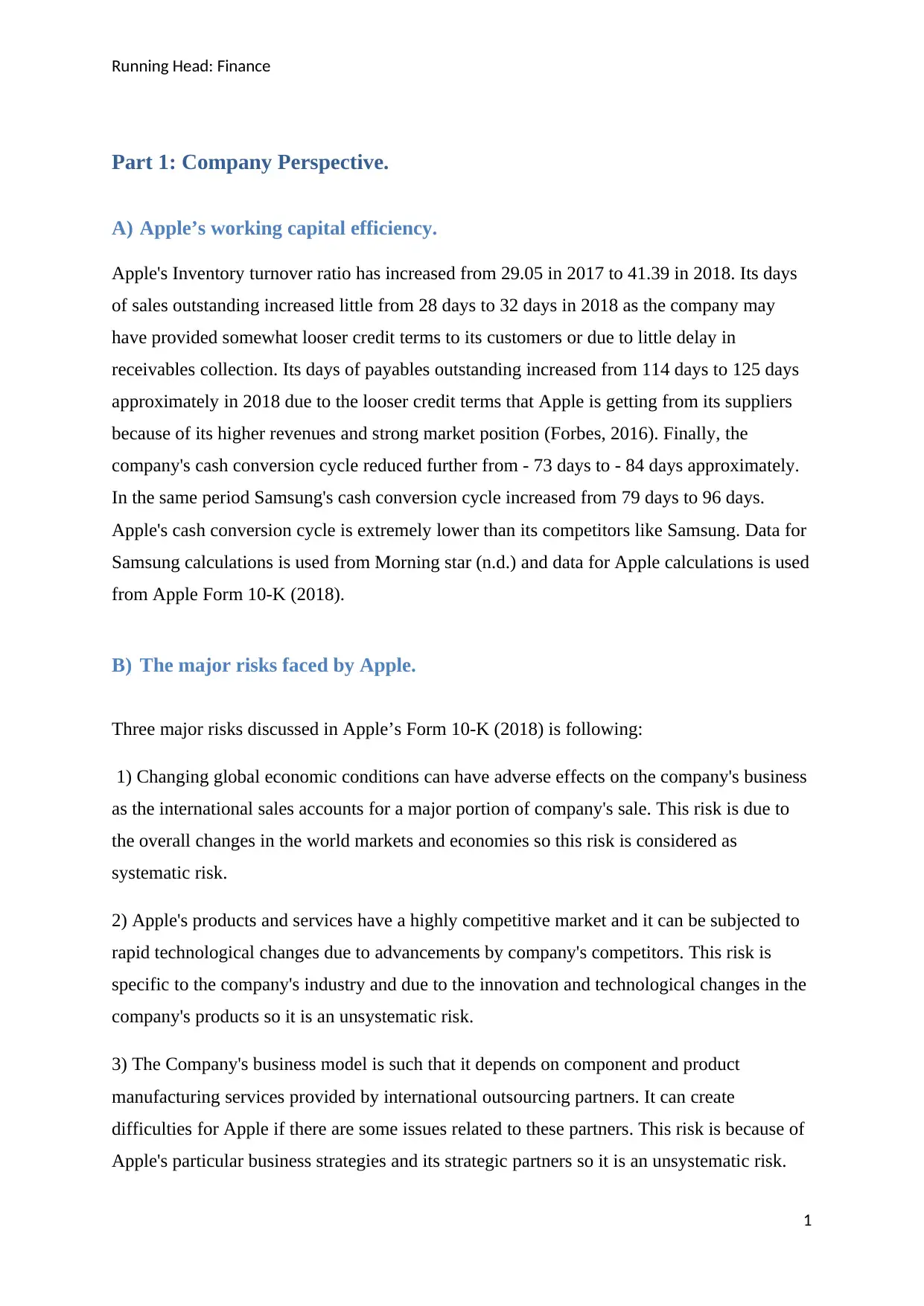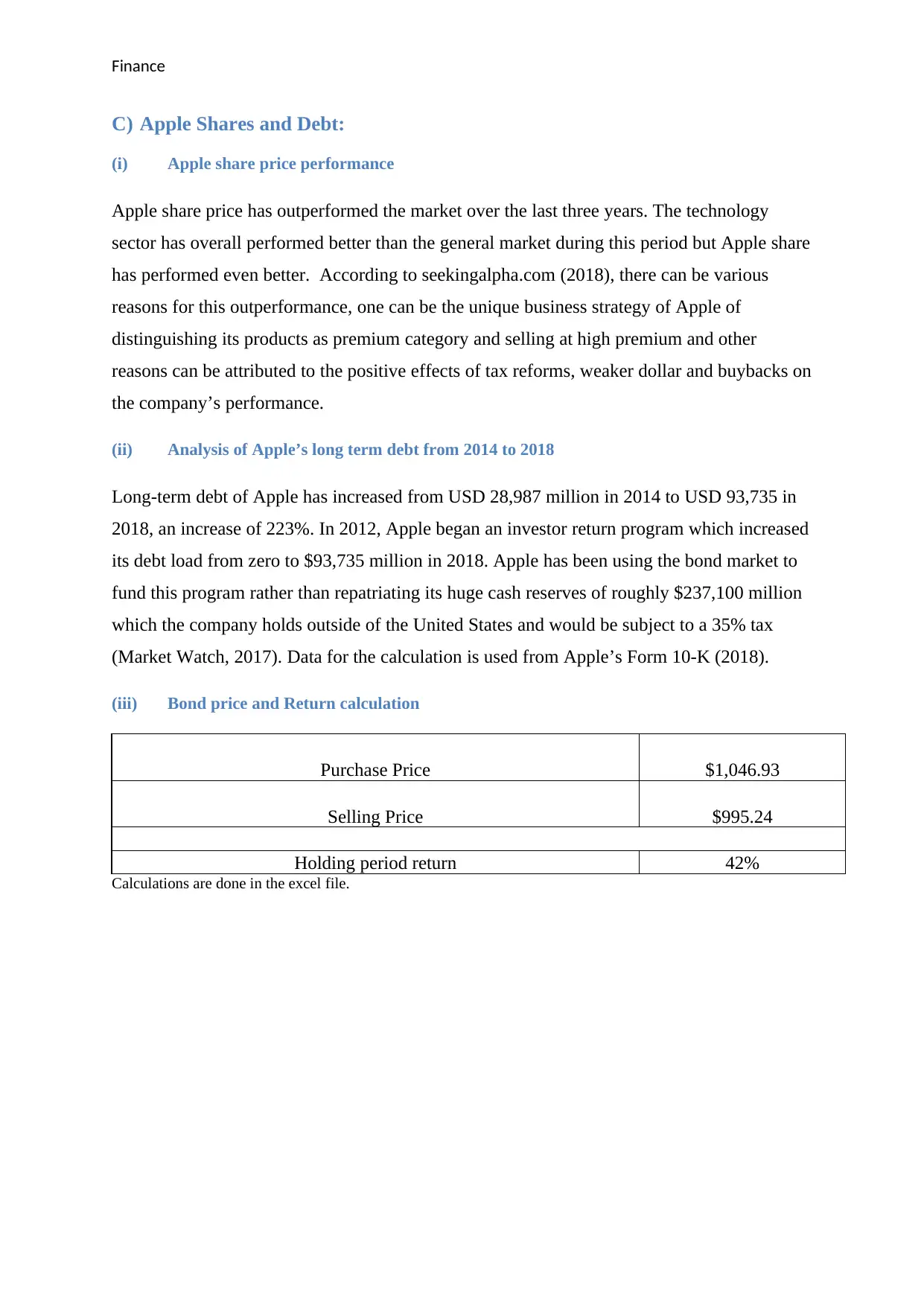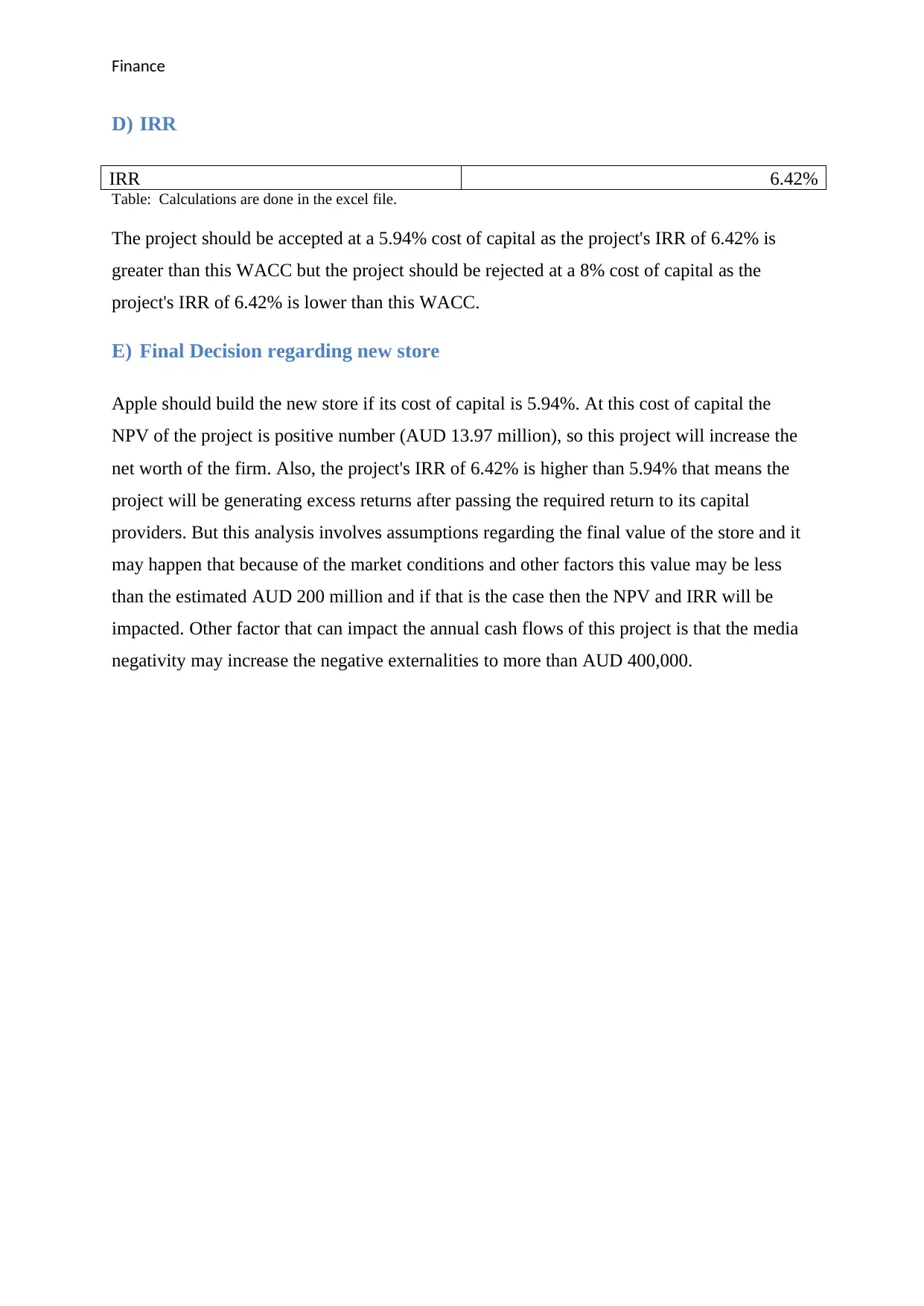FINM4000 Finance: Apple and Capital Budgeting Assignment
VerifiedAdded on 2023/03/17
|7
|1475
|94
Homework Assignment
AI Summary
This finance assignment analyzes Apple's financial performance and capital budgeting decisions. Part 1 examines Apple's working capital efficiency, major risks, share price performance, and long-term debt analysis from 2014 to 2018, including bond price and return calculations. Part 2 focuses on capital budgeting, addressing why land cost is excluded, calculating free annual cash flows, NPV with different WACCs, IRR, and the final decision regarding a new store, considering various financial metrics and assumptions. The assignment utilizes Apple's 2018 Annual Report and other sources to provide a comprehensive financial analysis, including detailed calculations and explanations for each section, and provides an Excel file with supporting calculations.

Running Head: Finance
Finance
Student Name
University Name
Finance
Student Name
University Name
Paraphrase This Document
Need a fresh take? Get an instant paraphrase of this document with our AI Paraphraser

Finance
Contents
Part 1: Company Perspective.................................................................................................................1
A) Apple’s working capital efficiency........................................................................................1
B) The major risks faced by Apple.............................................................................................1
C) Apple Shares and Debt:.........................................................................................................2
(i) Apple share price performance..............................................................................................2
(ii) Analysis of Apple’s long term debt from 2014 to 2018.....................................................2
(iii) Bond price and Return calculation.....................................................................................2
Part 2: Capital Budgeting......................................................................................................................3
A) Why does the analysis not consider the price of the land?............................................................3
B) Free annual cash flows..................................................................................................................3
C) NPV:.............................................................................................................................................3
(i) A WACC of 5.94%...............................................................................................................3
(ii) A WACC of 8%...................................................................................................................3
D) IRR........................................................................................................................................4
E) Final Decision regarding new store............................................................................................4
References:............................................................................................................................................5
Contents
Part 1: Company Perspective.................................................................................................................1
A) Apple’s working capital efficiency........................................................................................1
B) The major risks faced by Apple.............................................................................................1
C) Apple Shares and Debt:.........................................................................................................2
(i) Apple share price performance..............................................................................................2
(ii) Analysis of Apple’s long term debt from 2014 to 2018.....................................................2
(iii) Bond price and Return calculation.....................................................................................2
Part 2: Capital Budgeting......................................................................................................................3
A) Why does the analysis not consider the price of the land?............................................................3
B) Free annual cash flows..................................................................................................................3
C) NPV:.............................................................................................................................................3
(i) A WACC of 5.94%...............................................................................................................3
(ii) A WACC of 8%...................................................................................................................3
D) IRR........................................................................................................................................4
E) Final Decision regarding new store............................................................................................4
References:............................................................................................................................................5

Running Head: Finance
Part 1: Company Perspective.
A) Apple’s working capital efficiency.
Apple's Inventory turnover ratio has increased from 29.05 in 2017 to 41.39 in 2018. Its days
of sales outstanding increased little from 28 days to 32 days in 2018 as the company may
have provided somewhat looser credit terms to its customers or due to little delay in
receivables collection. Its days of payables outstanding increased from 114 days to 125 days
approximately in 2018 due to the looser credit terms that Apple is getting from its suppliers
because of its higher revenues and strong market position (Forbes, 2016). Finally, the
company's cash conversion cycle reduced further from - 73 days to - 84 days approximately.
In the same period Samsung's cash conversion cycle increased from 79 days to 96 days.
Apple's cash conversion cycle is extremely lower than its competitors like Samsung. Data for
Samsung calculations is used from Morning star (n.d.) and data for Apple calculations is used
from Apple Form 10-K (2018).
B) The major risks faced by Apple.
Three major risks discussed in Apple’s Form 10-K (2018) is following:
1) Changing global economic conditions can have adverse effects on the company's business
as the international sales accounts for a major portion of company's sale. This risk is due to
the overall changes in the world markets and economies so this risk is considered as
systematic risk.
2) Apple's products and services have a highly competitive market and it can be subjected to
rapid technological changes due to advancements by company's competitors. This risk is
specific to the company's industry and due to the innovation and technological changes in the
company's products so it is an unsystematic risk.
3) The Company's business model is such that it depends on component and product
manufacturing services provided by international outsourcing partners. It can create
difficulties for Apple if there are some issues related to these partners. This risk is because of
Apple's particular business strategies and its strategic partners so it is an unsystematic risk.
1
Part 1: Company Perspective.
A) Apple’s working capital efficiency.
Apple's Inventory turnover ratio has increased from 29.05 in 2017 to 41.39 in 2018. Its days
of sales outstanding increased little from 28 days to 32 days in 2018 as the company may
have provided somewhat looser credit terms to its customers or due to little delay in
receivables collection. Its days of payables outstanding increased from 114 days to 125 days
approximately in 2018 due to the looser credit terms that Apple is getting from its suppliers
because of its higher revenues and strong market position (Forbes, 2016). Finally, the
company's cash conversion cycle reduced further from - 73 days to - 84 days approximately.
In the same period Samsung's cash conversion cycle increased from 79 days to 96 days.
Apple's cash conversion cycle is extremely lower than its competitors like Samsung. Data for
Samsung calculations is used from Morning star (n.d.) and data for Apple calculations is used
from Apple Form 10-K (2018).
B) The major risks faced by Apple.
Three major risks discussed in Apple’s Form 10-K (2018) is following:
1) Changing global economic conditions can have adverse effects on the company's business
as the international sales accounts for a major portion of company's sale. This risk is due to
the overall changes in the world markets and economies so this risk is considered as
systematic risk.
2) Apple's products and services have a highly competitive market and it can be subjected to
rapid technological changes due to advancements by company's competitors. This risk is
specific to the company's industry and due to the innovation and technological changes in the
company's products so it is an unsystematic risk.
3) The Company's business model is such that it depends on component and product
manufacturing services provided by international outsourcing partners. It can create
difficulties for Apple if there are some issues related to these partners. This risk is because of
Apple's particular business strategies and its strategic partners so it is an unsystematic risk.
1
⊘ This is a preview!⊘
Do you want full access?
Subscribe today to unlock all pages.

Trusted by 1+ million students worldwide

Finance
C) Apple Shares and Debt:
(i) Apple share price performance
Apple share price has outperformed the market over the last three years. The technology
sector has overall performed better than the general market during this period but Apple share
has performed even better. According to seekingalpha.com (2018), there can be various
reasons for this outperformance, one can be the unique business strategy of Apple of
distinguishing its products as premium category and selling at high premium and other
reasons can be attributed to the positive effects of tax reforms, weaker dollar and buybacks on
the company’s performance.
(ii) Analysis of Apple’s long term debt from 2014 to 2018
Long-term debt of Apple has increased from USD 28,987 million in 2014 to USD 93,735 in
2018, an increase of 223%. In 2012, Apple began an investor return program which increased
its debt load from zero to $93,735 million in 2018. Apple has been using the bond market to
fund this program rather than repatriating its huge cash reserves of roughly $237,100 million
which the company holds outside of the United States and would be subject to a 35% tax
(Market Watch, 2017). Data for the calculation is used from Apple’s Form 10-K (2018).
(iii) Bond price and Return calculation
Purchase Price $1,046.93
Selling Price $995.24
Holding period return 42%
Calculations are done in the excel file.
C) Apple Shares and Debt:
(i) Apple share price performance
Apple share price has outperformed the market over the last three years. The technology
sector has overall performed better than the general market during this period but Apple share
has performed even better. According to seekingalpha.com (2018), there can be various
reasons for this outperformance, one can be the unique business strategy of Apple of
distinguishing its products as premium category and selling at high premium and other
reasons can be attributed to the positive effects of tax reforms, weaker dollar and buybacks on
the company’s performance.
(ii) Analysis of Apple’s long term debt from 2014 to 2018
Long-term debt of Apple has increased from USD 28,987 million in 2014 to USD 93,735 in
2018, an increase of 223%. In 2012, Apple began an investor return program which increased
its debt load from zero to $93,735 million in 2018. Apple has been using the bond market to
fund this program rather than repatriating its huge cash reserves of roughly $237,100 million
which the company holds outside of the United States and would be subject to a 35% tax
(Market Watch, 2017). Data for the calculation is used from Apple’s Form 10-K (2018).
(iii) Bond price and Return calculation
Purchase Price $1,046.93
Selling Price $995.24
Holding period return 42%
Calculations are done in the excel file.
Paraphrase This Document
Need a fresh take? Get an instant paraphrase of this document with our AI Paraphraser

Finance
Part 2: Capital Budgeting.
A) Why does the analysis not consider the price of the land?
Land cost should not be considered for the analysis as it is a sunk cost which company has
already spent while purchasing this land and it does not matter whether Apple goes ahead
with the plan of building this store or not. So, the price of this land does not have any effect
on the capital budgeting decision regarding this project.
B) Free annual cash flows
Annual free cash flows (not including the onetime initial and ending cash flows) for years 1
to 5 are AUD 23.23 million and for years 5 to 20 are AUD 23.51 million. Calculations details
are in the excel file.
C) NPV:
(i) A WACC of 5.94%.
WACC 5.94%
NPV AUD 13.97 million
Table: Calculations are done in the excel file.
(ii) A WACC of 8%.
WACC 8.00%
NPV -AUD 40.24 million
Table: Calculations are done in the excel file.
This project should be taken if WACC is 5.94% as this gives NPV of AUD 13.97 million but
the project should be rejected if WACC is 8% as this gives NPV of - AUD 40.24 million.
Part 2: Capital Budgeting.
A) Why does the analysis not consider the price of the land?
Land cost should not be considered for the analysis as it is a sunk cost which company has
already spent while purchasing this land and it does not matter whether Apple goes ahead
with the plan of building this store or not. So, the price of this land does not have any effect
on the capital budgeting decision regarding this project.
B) Free annual cash flows
Annual free cash flows (not including the onetime initial and ending cash flows) for years 1
to 5 are AUD 23.23 million and for years 5 to 20 are AUD 23.51 million. Calculations details
are in the excel file.
C) NPV:
(i) A WACC of 5.94%.
WACC 5.94%
NPV AUD 13.97 million
Table: Calculations are done in the excel file.
(ii) A WACC of 8%.
WACC 8.00%
NPV -AUD 40.24 million
Table: Calculations are done in the excel file.
This project should be taken if WACC is 5.94% as this gives NPV of AUD 13.97 million but
the project should be rejected if WACC is 8% as this gives NPV of - AUD 40.24 million.

Finance
D) IRR
IRR 6.42%
Table: Calculations are done in the excel file.
The project should be accepted at a 5.94% cost of capital as the project's IRR of 6.42% is
greater than this WACC but the project should be rejected at a 8% cost of capital as the
project's IRR of 6.42% is lower than this WACC.
E) Final Decision regarding new store
Apple should build the new store if its cost of capital is 5.94%. At this cost of capital the
NPV of the project is positive number (AUD 13.97 million), so this project will increase the
net worth of the firm. Also, the project's IRR of 6.42% is higher than 5.94% that means the
project will be generating excess returns after passing the required return to its capital
providers. But this analysis involves assumptions regarding the final value of the store and it
may happen that because of the market conditions and other factors this value may be less
than the estimated AUD 200 million and if that is the case then the NPV and IRR will be
impacted. Other factor that can impact the annual cash flows of this project is that the media
negativity may increase the negative externalities to more than AUD 400,000.
D) IRR
IRR 6.42%
Table: Calculations are done in the excel file.
The project should be accepted at a 5.94% cost of capital as the project's IRR of 6.42% is
greater than this WACC but the project should be rejected at a 8% cost of capital as the
project's IRR of 6.42% is lower than this WACC.
E) Final Decision regarding new store
Apple should build the new store if its cost of capital is 5.94%. At this cost of capital the
NPV of the project is positive number (AUD 13.97 million), so this project will increase the
net worth of the firm. Also, the project's IRR of 6.42% is higher than 5.94% that means the
project will be generating excess returns after passing the required return to its capital
providers. But this analysis involves assumptions regarding the final value of the store and it
may happen that because of the market conditions and other factors this value may be less
than the estimated AUD 200 million and if that is the case then the NPV and IRR will be
impacted. Other factor that can impact the annual cash flows of this project is that the media
negativity may increase the negative externalities to more than AUD 400,000.
⊘ This is a preview!⊘
Do you want full access?
Subscribe today to unlock all pages.

Trusted by 1+ million students worldwide

Finance
References:
Apple Form 10-K (2018). Apple Annual Report. pp. 38-40. Accessed 9 May 2019:
https://s22.q4cdn.com/396847794/files/doc_financials/quarterly/2018/Q4/10-K-2018-(As-
Filed).pdf.
Apple Form 10-K (2018). Apple Annual Report. pp. 8-17. Accessed 9 May 2019:
https://s22.q4cdn.com/396847794/files/doc_financials/quarterly/2018/Q4/10-K-2018-(As-
Filed).pdf.
Apple Form 10-K (2018). Apple Annual Report. pp. 21. Accessed 9 May 2019:
https://s22.q4cdn.com/396847794/files/doc_financials/quarterly/2018/Q4/10-K-2018-(As-
Filed).pdf.
Forbes. (2016). Why Is Apple's Cash Conversion Cycle Significantly Shorter Than
Samsung's? Accessed 9 May 2019:
https://www.forbes.com/sites/greatspeculations/2016/06/07/why-is-apples-cash-conversion-
cycle-significantly-shorter-than-samsungs/#4c3810fe58eb.
MarketWatch. (2017). Apple is once again borrowing in the bond market to reward its
shareholders. Accessed 9 May 2019: https://www.marketwatch.com/story/apple-is-once-
again-borrowing-in-the-bond-market-to-reward-its-shareholders-2017-05-04.
Morningstar. (2018). Samsung Electronics Co Ltd Key Ratios. Accessed 9 May 2019:
http://financials.morningstar.com/ratios/r.html?t=SSNLF®ion=usa&culture=en-US.
Seekingalpha. (2018). Apple Is Outperforming, But. Accessed 9 May 2019:
https://seekingalpha.com/article/4209381-apple-outperforming?page=2.
References:
Apple Form 10-K (2018). Apple Annual Report. pp. 38-40. Accessed 9 May 2019:
https://s22.q4cdn.com/396847794/files/doc_financials/quarterly/2018/Q4/10-K-2018-(As-
Filed).pdf.
Apple Form 10-K (2018). Apple Annual Report. pp. 8-17. Accessed 9 May 2019:
https://s22.q4cdn.com/396847794/files/doc_financials/quarterly/2018/Q4/10-K-2018-(As-
Filed).pdf.
Apple Form 10-K (2018). Apple Annual Report. pp. 21. Accessed 9 May 2019:
https://s22.q4cdn.com/396847794/files/doc_financials/quarterly/2018/Q4/10-K-2018-(As-
Filed).pdf.
Forbes. (2016). Why Is Apple's Cash Conversion Cycle Significantly Shorter Than
Samsung's? Accessed 9 May 2019:
https://www.forbes.com/sites/greatspeculations/2016/06/07/why-is-apples-cash-conversion-
cycle-significantly-shorter-than-samsungs/#4c3810fe58eb.
MarketWatch. (2017). Apple is once again borrowing in the bond market to reward its
shareholders. Accessed 9 May 2019: https://www.marketwatch.com/story/apple-is-once-
again-borrowing-in-the-bond-market-to-reward-its-shareholders-2017-05-04.
Morningstar. (2018). Samsung Electronics Co Ltd Key Ratios. Accessed 9 May 2019:
http://financials.morningstar.com/ratios/r.html?t=SSNLF®ion=usa&culture=en-US.
Seekingalpha. (2018). Apple Is Outperforming, But. Accessed 9 May 2019:
https://seekingalpha.com/article/4209381-apple-outperforming?page=2.
1 out of 7
Related Documents
Your All-in-One AI-Powered Toolkit for Academic Success.
+13062052269
info@desklib.com
Available 24*7 on WhatsApp / Email
![[object Object]](/_next/static/media/star-bottom.7253800d.svg)
Unlock your academic potential
Copyright © 2020–2025 A2Z Services. All Rights Reserved. Developed and managed by ZUCOL.





